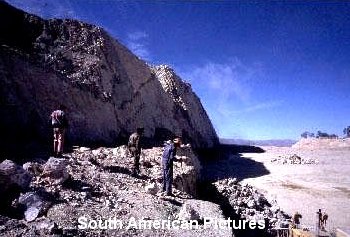In
the Footsteps of the Dinosaurs |
|

| During
the Cretaceous Period of geological history between 136 and 65 million years ago
these huge slabs of rock were simply a bed of soft mud around a drying freshwater
lake. The tectonic movements of the earth's crustal plates has thrust the ancient
sediments upwards at an extraordinary angle of 73 degrees from the horizontal.
The main face or cliff is 80m high and up to 1.2km long. Today this is a limestone
quarry known as Cal Orko - cal in Spanish means 'lime' - and although the fossils
had been known for some time workers only began to uncover the tracks in 1994. | |
|
| More
than 8 different species of dinosaurs are believed to have crossed this drying
lake bed. As it hardened their footprints were covered by more sediments or perhaps
the dust from the surrounding land. They have been held in a time-capsule for
between 65 and 75 million years. One set of tracks made by a theropod dinosaur
stretches for 350m and is the longest ever recorded. The largest prints are from
the huge titanosaurs a quadripedal [walking on four legs] plant eater.
These gigantic beasts reached a length of between 15 and 25m. According to the
palaeontologists studying the trackways the most important discovery has been
the prints of ankylosaurs. These were four legged animals with a heavy
plated armour and were previously unknown in dinosaur records from South America. | |
|
 | The
footprints are now carefully guarded and are being studied by Bolivian, Swiss
and other international palæontologists.. The site is now a tourist attraction
with English speaking guides. Until the full extent of the discovery was known
the largest set of dinosaur tracks was believed to be in Asia at Khjoda-Pil-ata
in Turkmenistan. The Sucre site with more than 5000 prints covering 25,000 m2
is now recognised as the largest in the world. It has not only led to a better
understanding dinosaurs of South America but to the entire science of early life
in this corner of the ancient world. Other fossils from the area suggest that
the the dinosaurs gathered at the lakeside to search for food. With time studies
will reveal much more evidence and already another site has been found. |
| |
|
More
information can be found by searching for the name of Dr. Cristian Meyer the palæontologist
who led the research Thanks
are also given to the late Dr. Alan Charig of the British Museum [Natural History]
and the late Dr. Ovidio Suárez Morales of the Bolivian National Academy
of Sciences for their inspiring comments about dinosaurs in Bolivia long before
these tracks were discovered |
|
|
| The
text and most of the images are © Copyright |
| For
any commercial use please contact | | |
| THE
NONESUCH - FLOWER OF BRISTOL |
| AN
EMBLEM FOR ENTERPRISE | | |